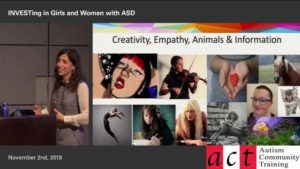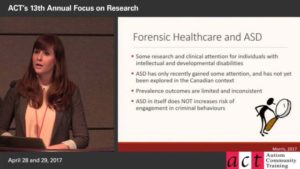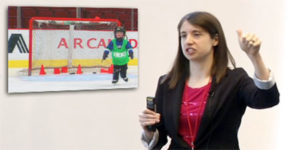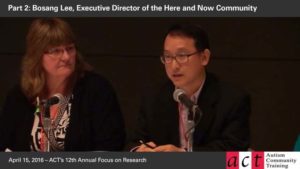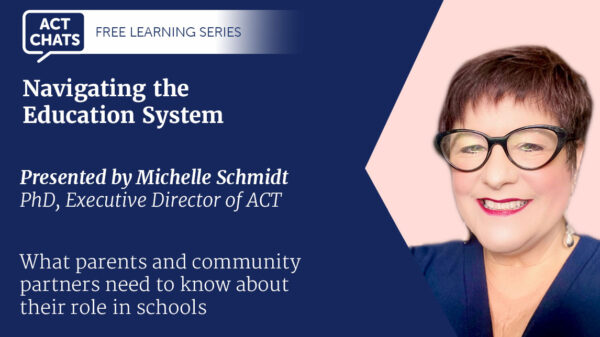Filmed October 2015 – edited into 20 parts; total 202 minutes
In this video, Dr. Weiss looks at how to promote positive outcomes in youth with ASD, including those with Intellectual Disability, by focusing on indicators such as happiness, satisfaction and resilience. This presentation has significant implications for educators, families and therapists as they look at the pivotal interventions that will have the biggest impacts on youth with ASD as they prepare and enter into adult life, specifically, interventions that target social-communication difficulties and promote social interaction and community inclusion for youth with ASD.
This video includes a panel presentation with Dr. Anthony Bailey, UBC; Patrick Dwyer, student and self-advocate; Dr. Stephanie Jull, Canucks Autism Network; Dr. Rashmeen Nirmal, Sunny Hill Health Centre and Dr. David Worling, Westcoast Child Development Group.
Part 1: Introduction (4:06)
- Weiss, J.A., Whelan, M., McMorris, C., Carroll, C. and the Canadian Autism Spectrum Disorder Alliance (2014) Autism in Canada: National Needs Assessment Survey for Families, Individuals with Autism Spectrum Disorder and Professionals
Part 2: Mental Health Rates in Autism (17:58)
- Facing your Fears (Reaven, et al., 2011). Paul Brookes.
- Child anxiety disorders: a family based treatment manual for practitioners (Wood, et al., 2008). WW Norton & Co.
- Exploring Feelings (anger/anxiety) Attwood, 2004). Future Horizons.
- Coping Cat (Kendall & Hedtke, 2006). Workbook Pub.
Part 3: What Does Good Mental Health Look Like? (4:56)
Part 4: Definitions, Components and Dynamics of Thriving (12:46)
Part 5: Predictors of Parent Reported Thriving (10:28)
Weiss, J.A. &Burnham, Riosa, P. (015). Thriving in Youth with Autism Spectrum Disorder and Intellectual Disability.
Part 6: Thriving: Building Individual Strengths (16:20)
- VIDEO CLIP: Learning to Flirt: https://www.youtube.com/watch?v=eIqFrbgBEQY
- PEERS program: www.semel.ucla.edu/peers
- Self-management training: www.iidc.indiana.edu/pages/Dont-Forget-About-Self-Management
- Calm, Alert, and Learning. Classroom Strategies for Self-Regulation, By Shanker, Stuart
- Asperger Syndrome and Adolescence. Helping Preteens and Teens Get Ready for the Real World, By Bolick, Teresa
- How Does Your Engine Run? A Leader’s Guide to the Alert Program for Self-Regulation, By Williams, Mary Sue with Shellenberger, Sherry
- Evidence-Based Social Skills Training for Adolescents with Autism Spectrum Disorders: The UCLA PEERS Program By Laugeson, Elizabeth A., Frankel, Fred, Gantman, Alexander, Dillon, Ashley R., and Mogil, Catherine
- A is for Autism, F is for Friend. A Kid’s Book on Making Friends with a Child Who Has Autism, By Keating-Velasco, Joanna L.
- A 5 is Against the Law! Social Boundaries: Straight Up! An Honest Guide for Teens and Young Adults, By Buron, Kari Dunn
Part 7: Thriving: Physical Health and Emotional Skills (6:42)
- VIDEO CLIP: Autism Exercise – Champion Rachel: www.youtube.com/watch?v=uYJcw_bA8sI
- VIDEO CLIP: Mindfulness: www.youtube.com/watch?v=cj3nS5y8TD4
- Sitting Still Like a Frog. Mindfulness Exercises for Kids (and Their Parents), BySnel, Eline
- Benefits of Mindful Parenting in Children with Autism, By Autism Spectrum Disorders Treatment and Care Research Group
Part 8: What are Your Strengths? (6:07)
VIDEO CLIP: Does this Make my Aspergers Look Big?
Part 9: Ecological Assets: Context (14:14)
- VIDEO CLIP: www.youtube.com/watch?v=R2qxwg_4vGc
- Post-Secondary Program at Simon Fraser University and at York University.
- Everyone Belongs in our Schools. A Parent’s Handbook on Inclusive Education, By Inclusion BC
- IEP and Inclusion Tips for Parents and Teachers, By Eason, Anne I. with Whitbread, Kathleen
Part 10: Family Distress, Resilience and Intervention (8:52)
- VIDEO CLIP: www.youtube.com/watch?v=XIryQI2m_oE
- Weiss, J.A., Cappadocia, M.C, Tint, A., & Pepler, D. (2015). Bullying Victimization, Parenting Stress, and Anxiety among Adolescents and Young Adults with Autism Spectrum Disorder.
- Mindfulness-Based Positive Behavior Support (MBPBS) for Mothers of Adolescents with Autism Spectrum Disorder: Effects on Adolescents’ Behavior and Parental Stress (Singh, NN et al. 2014)
- Mindfulness based stress reduction (Dykens et al., 2014)
- Parents training to work with kids through PRT (Minjarex et al., 2013)
- Benefits of Mindful Parenting in Children with Autism -By Autism Spectrum Disorders Treatment and Care Research Group
- A Teen’s Guide to Understanding and Communicating with People with Autism, ByAlexandra Jackman
- Autism & Safety: Bullying, By National Autism Association
- Being Bullied. Strategies and Solutions for People with Asperger’s Syndrome, By Dubin, Nick with Dubin, Larry
- Bullying and Victimization in Youth with Autism Spectrum Disorders, By Autism Spectrum Disorders Treatment and Care Research Group
- Freaks, Geeks & Asperger Syndrome. A User Guide to Adolescence, ByJackson, Luke with Attwood, Tony [Foreword]
Part 11: Services: Use, Barriers and Needs – B.C. Results (8:19)
Part 12: Collective Activity and Predictors of Employment (11:06)
- Achieving Social and Economic Inclusion: From Segregation to ‘Employment First’ – Law Reform and Public Policy Series By Canadian Association for Community Living
- ACT’s Autism Manual for BC Chapter 12 – Guide to Employment for Teens and Adults with Autism in B.C
Part 13: Panel Part 1- Panellist Comments (20:58)
Part 14: Panel Part 2 – Preparing for Post-Secondary (8:08)
Part 15: Panel Part 3- Honouring the Child’s Interests (13:03)
Part 16: Panel Part 4 – Responses to Bullying (5:30)
Part 17: Panel Part 5 – Promoting Continuity or Stability (6:14)
Part 18: Panel Part 6 – Learning for Individuals with ASD (13:46)
Part 19: Panel Part 7 – Capacity in the School System (4:28)
Part 20: Panel Part 8 – Students With ASD and Mental Health Complexities (8:08)


